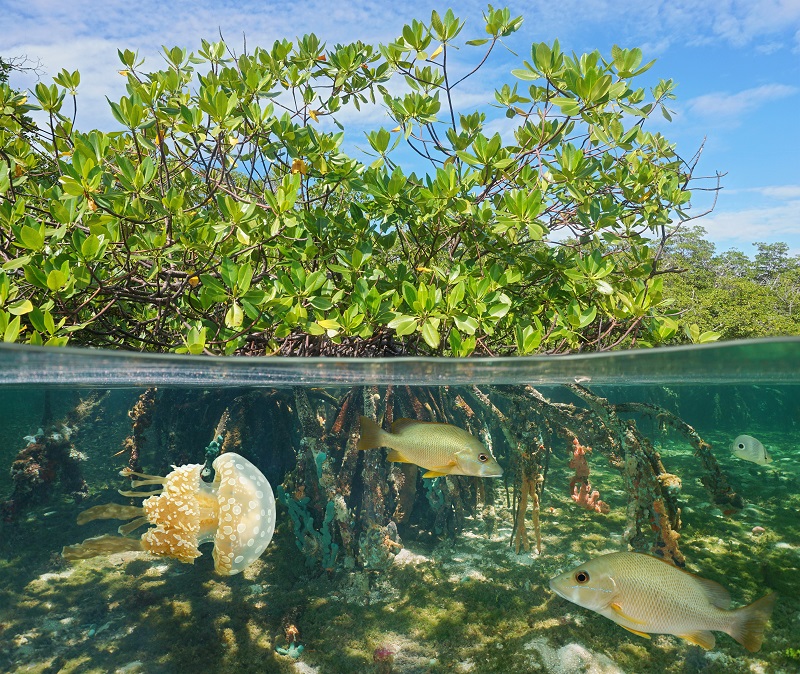Definition
A biotic factor is a living thing that has an impact on another population of living things or on the environment. Abiotic factors do the same thing, but they are non-living. Together, biotic and abiotic factors make up an ecosystem. To survive, biotic factors need abiotic factors. In turn, biotic factors can limit the kinds and amounts of biotic factors in an ecosystem.

Comparison Chart
| Biotic Factors | Abiotic Factors | |
|---|---|---|
| Are they living things? | Yes | No |
| Examples | Animals, plants, fungi, bacteria – all living things | Forest fires, water, climate, habitat, soil, minerals, human activity |
| Main categories | Producers, consumers, decomposers | Atmosphere, chemical elements, sunlight/temperature, wind, and water |
| Main types | Living things | Chemical and physical things |
| Affect ecosystems? | Yes | Yes |
Biotic Factors
Biotic factors are both organisms and the food the organisms eat. There are 3 categories of biotic factors, autotrophs, heterotrophs, and detritivores.
Autotrophs
The word autotroph means “self-feeder.” Also known as producers, the organisms in this category are mostly green plants and algae which make their own food through photosynthesis. The energy that they store serves as food for the consumers and decomposers (see below) either directly or indirectly.
Autotrophs that don’t use photosynthesis to make their food use another process called chemosynthesis. In this case, organisms take organic material from their environment and transform it into organic nutrients, without the need for sunlight. A good example of this are the specialized bacteria that live near hydrothermal vents in the ocean and extract hydrogen sulfide from the water.
Autotrophs use some of the energy they make to change elemental carbon into organic compounds (called carbon fixation) during photosynthesis or chemosynthesis. Although they feed on simple food sources, autotrophs are the base that drives the entire ecosystem.
Heterotrophs
Heterotrophs (“other feeders”) are consumers in the ecosystem. They eat more complex organisms like plants and/or animals. Some examples of heterotrophs are bacteria, protists, fungi, herbivores (deer, cows, sheep), carnivores (bears, lions, dogs), and omnivores (birds, squirrels, rats, and humans). In fact, about 95% of all living things on Earth are heterotrophs. Unlike autotrophs, heterotrophs don’t have to fix carbon, so they can take advantage of all the energy from the food they eat.

Detritivores
Detritivores are also consumers but they get their own category because of what they feed on. These organisms are also referred to as the decomposers, and they either eat dead organisms directly or break down dead things to get energy. Examples of detritivores are earthworms, fungi, dung beetles, millipedes, sea stars, and fiddler crabs. The complex cycle of interaction between biotic and abiotic factors continues as the decomposers clean up after the producers and consumers, but serve as food for the heterotrophs at the same time.
Abiotic Factors
The non-living abiotic factors control which organisms live in an ecosystem, where they live, and how many of them are there. Even slight changes in abiotic factors can have a significant effect on organisms in and ecosystem. Broadly, there are 3 categories of abiotic factors, climatic, edaphic, and social.
Climatic
Climatic factors are components such as water, sunlight, humidity, climate, temperature, and pH. For organisms that live in the water, sound waves, tides, water clarity, sunlight exposure, and pressure are also considered abiotic factors. Living organisms can take advantage of abiotic factors. For example, the wind can disperse seeds in the air which helps with pollination and gives plants the opportunity to spread. The wind is also a great example of an abiotic factor that affects many others. For example, wind direction and speed can affect humidity.
Edaphic
Edaphic comes from the Greek word edaphos which means floor. It refers to abiotic factors like the geography of the land, and soil characteristics such as the mineral content. The topography of the land such as elevations, mountains, valleys, depressions, and slopes all contribute to the characteristics of an ecosystem. Similarly, soil characteristics like composition, texture, structure, and density determine what creatures can live there, and which plants can grow.
Social
Social abiotic factors describe how human activity can impact the land and resources in the area. Humans have an impact on many features of an ecosystem, but social factors are most likely to cause to larger-scale change. Thus, they can have profound impacts on other abiotic factors, biotic factors, entire ecosystems, and even entire biomes. Examples of social abiotic factors are clear-cutting of forests, mining, dam building, and farming.
Bibliography
- Biotic factors. (2002). In Encyclopedia.com. Retrieved from http://www.encyclopedia.com/earth-and-environment/ecology-and-environmentalism/environmental-studies/biotic-factor
- Abiotic component. (n.d.). In Wikipedia. Retrieved June 1, 2017 from https://en.wikipedia.org/wiki/Abiotic_component
- Brite, K. (Updated April 25, 2017). Five different types of abiotic factors. Retrieved from http://sciencing.com/five-different-types-abiotic-factors-7762257.html
